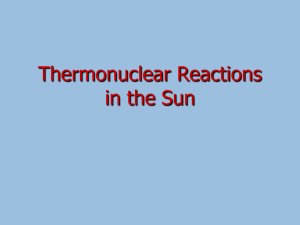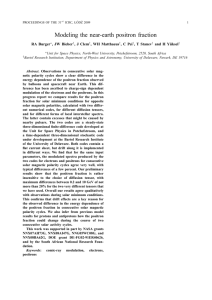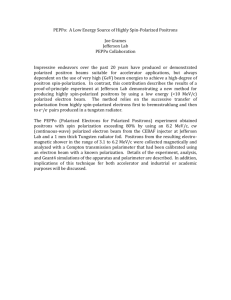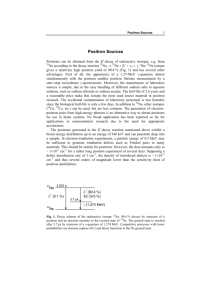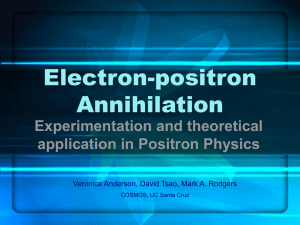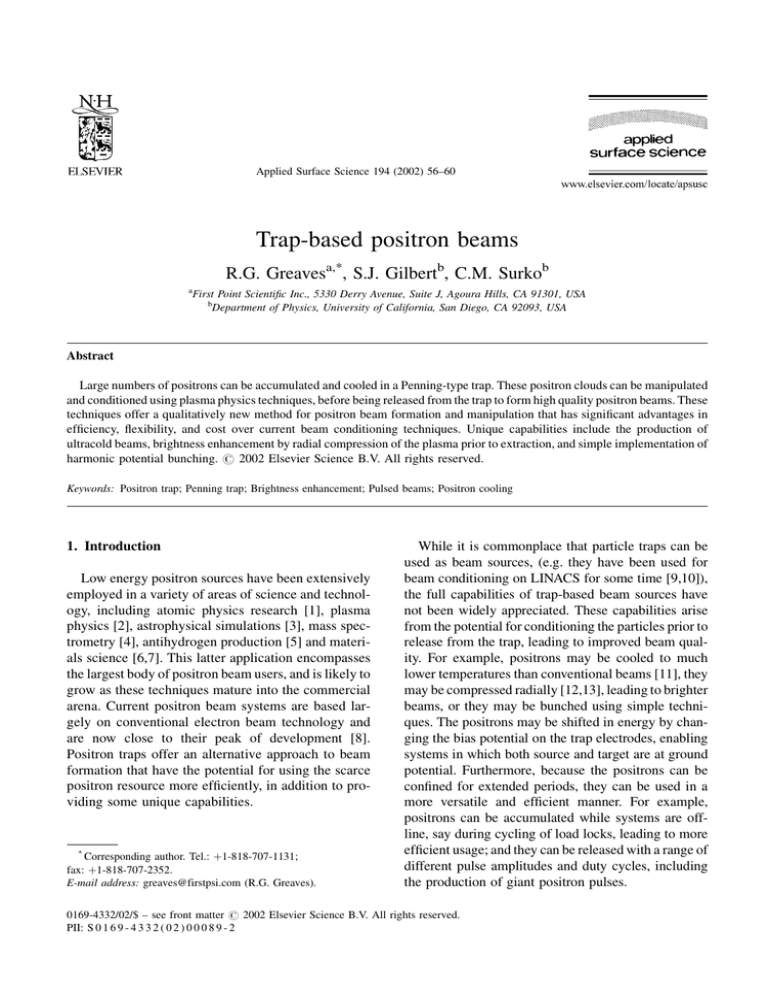
Applied Surface Science 194 (2002) 56–60
Trap-based positron beams
R.G. Greavesa,*, S.J. Gilbertb, C.M. Surkob
a
First Point Scientific Inc., 5330 Derry Avenue, Suite J, Agoura Hills, CA 91301, USA
b
Department of Physics, University of California, San Diego, CA 92093, USA
Abstract
Large numbers of positrons can be accumulated and cooled in a Penning-type trap. These positron clouds can be manipulated
and conditioned using plasma physics techniques, before being released from the trap to form high quality positron beams. These
techniques offer a qualitatively new method for positron beam formation and manipulation that has significant advantages in
efficiency, flexibility, and cost over current beam conditioning techniques. Unique capabilities include the production of
ultracold beams, brightness enhancement by radial compression of the plasma prior to extraction, and simple implementation of
harmonic potential bunching. # 2002 Elsevier Science B.V. All rights reserved.
Keywords: Positron trap; Penning trap; Brightness enhancement; Pulsed beams; Positron cooling
1. Introduction
Low energy positron sources have been extensively
employed in a variety of areas of science and technology, including atomic physics research [1], plasma
physics [2], astrophysical simulations [3], mass spectrometry [4], antihydrogen production [5] and materials science [6,7]. This latter application encompasses
the largest body of positron beam users, and is likely to
grow as these techniques mature into the commercial
arena. Current positron beam systems are based largely on conventional electron beam technology and
are now close to their peak of development [8].
Positron traps offer an alternative approach to beam
formation that have the potential for using the scarce
positron resource more efficiently, in addition to providing some unique capabilities.
*
Corresponding author. Tel.: þ1-818-707-1131;
fax: þ1-818-707-2352.
E-mail address: greaves@firstpsi.com (R.G. Greaves).
While it is commonplace that particle traps can be
used as beam sources, (e.g. they have been used for
beam conditioning on LINACS for some time [9,10]),
the full capabilities of trap-based beam sources have
not been widely appreciated. These capabilities arise
from the potential for conditioning the particles prior to
release from the trap, leading to improved beam quality. For example, positrons may be cooled to much
lower temperatures than conventional beams [11], they
may be compressed radially [12,13], leading to brighter
beams, or they may be bunched using simple techniques. The positrons may be shifted in energy by changing the bias potential on the trap electrodes, enabling
systems in which both source and target are at ground
potential. Furthermore, because the positrons can be
confined for extended periods, they can be used in a
more versatile and efficient manner. For example,
positrons can be accumulated while systems are offline, say during cycling of load locks, leading to more
efficient usage; and they can be released with a range of
different pulse amplitudes and duty cycles, including
the production of giant positron pulses.
0169-4332/02/$ – see front matter # 2002 Elsevier Science B.V. All rights reserved.
PII: S 0 1 6 9 - 4 3 3 2 ( 0 2 ) 0 0 0 8 9 - 2
R.G. Greaves et al. / Applied Surface Science 194 (2002) 56–60
2. Positron trapping
A variety of techniques have been proposed or
developed for accumulating positrons in Penning traps
(see, e.g. [14] and references therein). However, the
only system that is efficient enough for high throughput systems is the buffer gas technique described
below [15].
Positrons are slowed to a few electron volts using a
solid neon moderator [16]. They are then injected into
the modified Penning–Malmberg trap shown in Fig. 1 in
the presence of a buffer gas. A magnetic field 0.1 tesla
is applied along the axis of the trap to provide radial
confinement. The accumulator has three stages, each at
successively lower gas pressure and electrostatic potential. As many as 30% of the incident positrons become
trapped in the third stage of the accumulator by electronic excitations of the N2 buffer gas and they cool to
room temperature in 0.1 s by vibrational and rotational excitations of the buffer gas [17]. Using this
technique, 3 108 positrons have been accumulated
in 8 min from a 90-mCi 22 Na source. Positrons can be
cooled to even lower temperatures if they are transferred to a cryogenic environment after they are
trapped. A system of this type, using differential pumping to isolate the cryogenic section, is now under
Fig. 1. Schematic diagram of a gas-buffered positron trap, showing
the three stages of differential pumping and the electrostatic
potential.
57
construction [18]. Once the positrons have been accumulated, they can be conditioned as described below,
and then released to form high-quality beams.
3. Beam-formation and bunching
Positron beams can be extracted from traps by
reducing the depth of the confining potential. This
can be accomplished either by reducing the potential
on one of the end confining electrodes, or by increasing the potential on the main electrode surrounding the
positrons while maintaining the end potentials fixed.
This latter method, which is illustrated in Fig. 2(a), has
the advantage that the positron beam has a narrow,
fixed beam energy determined by the end electrode
potential [11]. As shown in the insert to Fig. 2(a),
energy spreads as low as 18 meV can be routinely
obtained. These cold beams have already been
Fig. 2. Electrostatic potential profiles for beam formation using
traps: (a) simplest configuration with asymmetrical well and fixed
potential exit gate potential. The inset shows a typical parallel
energy distribution obtainable using room temperature positrons;
(b) the harmonic potential geometry, as described in text.
58
R.G. Greaves et al. / Applied Surface Science 194 (2002) 56–60
employed for atomic physics studies in a previously
inaccessible low-energy regime [19,20]. The changes
in the potential can be made either stepwise or
smoothly, leading to pulsed or quasi-steady state
‘‘pulse stretching’’ beams, respectively.
Traps are ideal for the implementation of beam
bunching by the elegant technique of harmonic potential bunching [21]. This technique, illustrated in
Fig. 2(b), imposes a quadratic potential on the flight
path of the positrons, leading to a spatial-temporal
focusing of the particles at the minimum of the
potential. For a flight path of length L, and accelerating
potential V0 , and a positron energy spread of DE, the
duration of the pulse is given by
rffiffiffiffi pffiffiffiffiffiffiffi
m L DE
Dt ¼ 2
:
(1)
e V0
From this equation, it can be seen that harmonic
potential bunching benefits significantly from the
use of trapped positrons, in that both L and DE can
be made much smaller than in conventional beam
systems, leading to shorter pulses. For example, with
V0 ¼ 500 V, L ¼ 10 cm, and DE ¼ 0:025 eV, one
would obtain Dt ¼ 150 ps, which would be suitable
for positron annihilation spectroscopy.
4. Brightness enhancement
Trap-based beam systems have the ability to produce brightness-enhanced beams by compressing the
positrons radially prior to release. This is accomplished by applying a rotating electric field to the
particles in the presence of a cooling mechanism.
This technique was recently demonstrated for positrons using buffer gas cooling [12,13]. A rotating
electric field was applied to clouds of 10–20 million
positrons confined in a Penning trap by applying
suitably phased sine waves to azimuthally segmented
electrodes surrounding the plasma. Cooling was provided by vibrational excitation of polyatomic gases at
pressures of 2108 Torr. The most effective cooling gases for this application were found to be CF4 and
SF6. At these pressures, positron annihilation is negligible (ta > 1000 s). As shown in Fig. 3, in this first
proof-of-principle experiment, rapid compression was
_
observed (N=N
15 s1 ), with the plasma diameter
being reduced from 3.5 to 0.7 mm in a few seconds.
In systems designed for this technique, significantly
greater compression is expected.
Another technique for brightness enhancement
using trapped positrons becomes possible if a significant amount of positron space charge can be accumulated in the trap. In this case, when the confining
voltage is reduced to release the positrons, they are
released first from the volume closest to the axis of the
charge cloud. Thus, the initial beam is narrower than
the charge cloud itself. For this technique to be
effectively employed for brightness enhancement,
only a small portion of the positrons should be
released. The rotating electric field, in combination
with natural cross-field transport processes could then
Fig. 3. Radial profiles of a positron plasma following the application of a rotating electric field at t ¼ 0. Conditions were: Ntot ¼ 107 positrons,
signal frequency, fw ¼ 2:5 MHz, signal amplitude Aw ¼ 56 mV. The cooling gas was CF4 at a pressure of 2 108 Torr.
R.G. Greaves et al. / Applied Surface Science 194 (2002) 56–60
be used to replenish the depleted central portion of the
plasma. The charge cloud would have to be continuously (or periodically) replenished to maintain the
total space charge. The condition for this technique
to function correctly is that the space charge potential
energy must be much greater than the thermal energy
of the positrons. This can be easily arranged in a
positron trap because of the low positron temperature.
For example, 5 million positrons (amounting to only a
few seconds accumulation) in a cloud 1 cm long
would have a space charge which modifies the space
potential by about 1.5 V, in comparison with the
positron energy spread of 0.025 eV.
5. Energy shifting
For many positron-based surface spectroscopy systems, positrons must be injected into the sample at
energies of several kilovolts or greater. Since dc
accelerating potentials are generally used, either the
source or the target must be at high potential. This
disadvantage can be overcome in trap-based beams by
accumulating the positrons at low potential from a
grounded source, and then raising the potential on the
trap electrodes so that the positrons can be injected
with high energy into a grounded target.
59
UHV trap. This device is expected to enable the
accumulation of large numbers of positrons (>1010 ),
and the confinement of high density (>1010 cm3 )
cryogenic plasmas (T < 10 K) with long lifetimes
(e.g. days to weeks). This device also has the potential
to produce very cold positron beams with parallel
energy spreads as low as 1 meV, FWHM.
7. Conclusion
A new generation of positron beam systems based
on the extraction of positrons from Penning traps is
now being developed. The cornerstone of these new
beam systems is the exploitation of techniques that
have been developed for manipulating single component positron and electron plasmas in traps. Unique
capabilities include the ability to supply ultracold
positrons, and to implement novel, high-efficiency
brightness enhancement schemes. Although these systems are still in the early stages of development, they
have already resulted in beams with state-of-the-art
performance. When incorporated into surface analysis
tools used by industry and in research, these systems
offer the potential for substantially improved performance at low cost. For scientific users, they offer new
capabilities and the potential to investigate regimes
not presently accessible to experiment.
6. Current developments
Acknowledgements
First Point Scientific Inc. is currently developing
trap-based positron beams for commercial applications [22]. Two systems are under development. One
is an advanced positron beam source (APBS), featuring a compact, reduced cost, two-stage version of
the system described in Section 2, with an integral
harmonic potential buncher for producing positron
pulses of 200 ps duration. The second is a positron
trap beam source (PTBS) designed to accumulate
positrons from the APBS and compress them using
a rotating electric field with the goal of producing
microbeams. The PTBS can also accommodate cryogenic electrodes for producing ultracold positron
beams.
At the University of California, San Diego, a cryogenic UHV trap is currently being constructed [18].
Positrons from a buffer gas trap will be stacked into a
The work at University of California, San Diego is
supported by the Office of Naval Research, Grant no.
N000-14-97-1-0366. The work at First Point Scientific
Inc., is supported by the Office of Naval Research,
Grant no. N00014-00-C-0710, and the National
Science Foundation, Grant no. DMI-0078468.
References
[1] W.E. Kauppila, T.S. Stein, Adv. Atomic Mol. Opt. Phys. 26
(1990) 1.
[2] R.G. Greaves, M.D. Tinkle, C.M. Surko, Phys. Plasmas 1
(1994) 1439.
[3] B.L. Brown, M. Leventhal, A.P. Mills Jr., D.W. Gidley, Phys.
Rev. Lett. 53 (1984) 2347.
[4] L.D. Hulett Jr., et al., Chem. Phys. Lett. 216 (1993) 236.
60
[5]
[6]
[7]
[8]
[9]
[10]
[11]
[12]
[13]
[14]
[15]
R.G. Greaves et al. / Applied Surface Science 194 (2002) 56–60
M. Charlton, et al., Phys. Rep. 241 (1994) 65.
P.J. Schultz, K.G. Lynn, Rev. Mod. Phys. 60 (1988) 701.
R.H. Howell, et al., Appl. Surf. Sci. 116 (1997) 7.
A.P. Mills Jr., Exp. Meth. Phys. Sci. 2A9 (1995) 39.
D. Segers, J. Paridaens, M. Dorikens, L. Dorikens-Vanpraet,
Nucl. Instrum. Meth. Phys. Res. A337 (1994) 246.
T. Akahane, et al., Appl. Phys. A 51 (1990) 146.
S.J. Gilbert, C. Kurz, R.G. Greaves, C.M. Surko, Appl. Phys.
Lett. 70 (1997) 1944.
R.G. Greaves, C.M. Surko, Phys. Rev. Lett. 85 (2000)
1883.
R.G. Greaves, C.M. Surko, Phys. Plasmas 8 (2001) 1879.
R.G. Greaves, C.M. Surko, Phys. Plasmas 4 (1997) 1528.
C.M. Surko, M. Leventhal, A. Passner, Phys. Rev. Lett. 62
(1989) 901.
[16] A.P. Mills Jr., E.M. Gullikson, Appl. Phys. Lett. 49 (1986) 1121.
[17] T.J. Murphy, C.M. Surko, Phys. Rev. A 46 (1992) 5696.
[18] C.M. Surko, S.J. Gilbert, R.G. Greaves, in: J.J. Bollinger,
R.L. Spencer, R.C. Davidson (Eds.), Proceedings of the AIP
Conference on Non-Neutral Plasma Physics III, Vol. 498,
AIP, Melville, New York, 1999, pp. 3–12.
[19] S.J. Gilbert, R.G. Greaves, C.M. Surko, Physical Review
Letters 82 (1999) 5032.
[20] J. Sullivan, S.J. Gilbert, C.M. Surko, Phys. Rev. Lett. 86
(2001) 1494.
[21] A.P. Mills Jr., Appl. Phys. 22 (1980) 273.
[22] R.G. Greaves, C.M. Surko, in: J.J. Bollinger, R.L. Spencer,
R.C. Davidson (Eds.), Proceedings of the AIP Conference on
Non-Neutral Plasma Physics III, Vol. 498, AIP, Melville, New
York, 1999, pp. 19–28.

